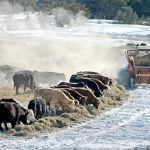Throughout November and December 2018, officials from the Canadian Food Inspection Agency (CFIA) and Agriculture and Agri-Food Canada (AAFC) consulted in Winnipeg, Ottawa, Saskatoon and Edmonton about a new framework for plant- breeding institutions to collect a return on their investment for the varieties they develop. The consultations began with some discussion on the concept of value capture in general and then discussed two potential systems for doing this.
The two models discussed were a trailing royalty on farm-saved seed and an end point royalty (EPR). Under the farm-saved seed royalty, producers would agree to certain conditions on saving their own seed when they bought certified seed of protected varieties. Once a producer purchased an eligible variety, they would be entered into a database and in subsequent years they would have to report how many acres they planted with saved seed of that variety. They would then be invoiced for those acres and pay a royalty that would be a reduced value of the certified seed royalty.
Read Also

Cancer agency reclassifies another herbicide ‘probably carcinogenic’
The WHO’s cancer research agency has now put atrazine, a herbicide well known to corn growers, in the same potential-hazard category where the agency put glyphosate.
Under an EPR, a non-refundable royalty would be payable on all harvested material. The royalty would be collected at the point of sale (i.e. an elevator) and royalties would be distributed to breeders based on their respective market share. There would be an exemption or rebate of the EPR for producers who purchased certified seed to produce that grain.
The current funding method
Currently plant breeding in Western Canada is funded in many ways. Hybrid canola is unique in the western Canadian context in that it is entirely funded by private companies that pay for it by charging what they need to or what the market will bear for seed that cannot legally be saved and replanted. For most other varieties of cereals and pulses, as well as oilseeds like flax, funding is a mixture of public money, collective producer funds and royalties based on seed purchases.
Public institutions like AAFC, universities in Edmonton, Saskatoon and Winnipeg, and provincial government branches like Alberta Agriculture and Forestry contribute federal and provincial tax dollars to research programs that develop new cultivars of cereals, pulses and flax.
Crop commissions like the wheat and barley commissions in all three Prairie provinces contribute to variety development projects and will be doing so at an even higher rate under the soon to be announced wheat science cluster that is part of the new Canadian Agricultural Partnership with the federal government. The pulse commissions have also contributed to variety development projects. Most notably, the Saskatchewan Pulse Growers has directed $53 million of producer checkoff dollars over the last 21 years to pulse breeding at the Crop Development Centre at the University of Saskatchewan.
When farmers buy certified seed, part of the seed price that they pay is a levy that certified seed growers remit to the seed company that has the commercialization rights for that variety. The seed companies keep some of this money for their activities and remit the royalty portion to the breeding institution. For example, if you buy AAC Brandon wheat in 2019, $1.27 per bushel will go back to Secan and it will remit whatever dollar figure it agreed upon to the breeding institution — in this case AAFC.
Sometimes seed companies use some portion of their revenue to fund plant breeding directly. For example, in 2014 Canterra, a seed company owned by Canadian seed growers, partnered with the Alberta Wheat Commission and AAFC to develop CPS wheat varieties for the Prairies.
Currently, there is no royalty collected on farm-saved seed in Canada and there is technically no end point royalty collected based on specific variety declarations at the end point.
Certified seed is grown on only a small number of acres (not including canola). In most of the Prairies, for example, the estimate is that about 20 per cent of wheat acres are sown with certified seed. There has been concern in the industry that because only 20 per cent of the acres pay into the royalty system, there is not enough ongoing funding for the development of important varieties in Canada.
Funding from AAFC
This reality is coupled with announcements in the last five years that governments, in particular AAFC, wanted to “get out of plant breeding.” Since then, AAFCs has backtracked on these claims somewhat, stating that it plans to remain involved in plant breeding.
Today, according to AAFC director general Liz Foster, the “federal investment for cereal crop research is expected to remain at current levels, subject to government priorities.” For the short term, according to Felicitas Katepa Mupondwa, who presented on behalf of AAFC at the Edmonton consultation, AAFC will continue to develop and commercialize cereal varieties, however, AAFC would like to see its role in plant breeding shift to higher-level background research or “discovery science” and engage private industry earlier in the variety development process.
Carla St. Croix, director of innovation and growth policy at AAFC, pointed out at the consultation meeting that wheat acres have generally been in decline since 1990 while canola acres have increased during that time to the point where wheat and canola acres are on par. Private investment in canola is obviously much higher as those varieties are developed by private companies like Bayer, Syngenta, Monsanto and others.
The presented slides read “additional investment in variety development could improve the competitiveness in cereal production,” but in the context of the meeting there was no evidence presented that said Canada was falling far behind other countries in terms of yield potential, when controlling for our climate and quality parameters.
According to St. Croix, the next phase of the consultation will include an online survey available on AAFC’s website. After that, AAFC and CFIA will determine if more face-to-face consultations are required. The regulations surrounding Plant Breeders’ Rights are scheduled to be reviewed in winter of 2020.
“If the consultation leads us to a particular model and we feel we have adequate stakeholder input to make certain decisions around rates, then we would move into regulatory design and it would move through the regulation process,” said St. Croix. As Anthony Parker, commissioner of the plant breeders’ rights office with the CFIA pointed out, the passing of UPOV ’91 in February of 2015 allowed for conditions to be placed on farmers, use of farm-saved seed.
“We were very clear in 2013 when the legislation was introduced into parliament. Every farm organization that was part of the process understood that the regulation making-authority was there,” said Parker.
















